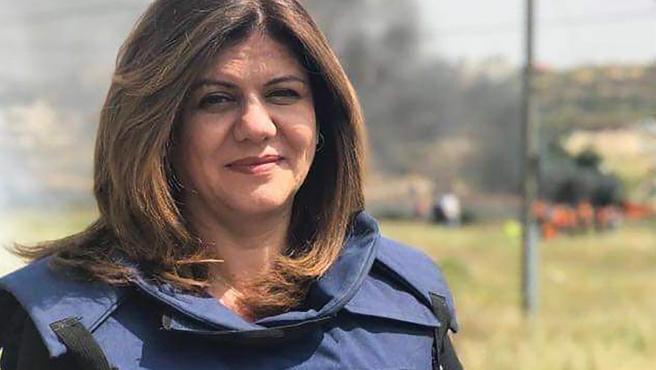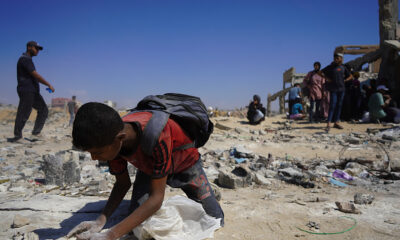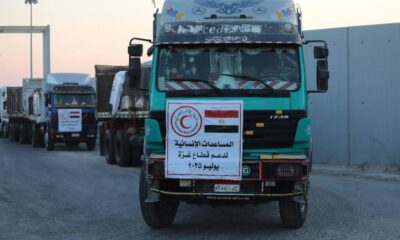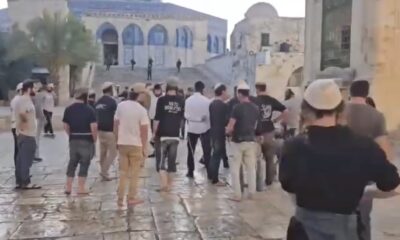Breaking News
Bullet that killed Shireen Abu Akleh came from Israeli gun, AP investigative report says

New York City – A reconstruction by The Associated Press lends support to assertions from both Palestinian authorities and Shireen Abu Akleh’s colleagues that the bullet that killed Al-Jazeera’s veteran reporter came from an Israeli gun.
Almost two weeks after the death of the veteran Palestinian-American reporter for Al Jazeera, The AP report says that multiple videos and photos taken on the morning of May 11 (the day when Abu Akleh was killed) show an Israeli convoy parked just up a narrow road from Abu Akleh, with a clear line of sight. They show the reporters and other bystanders in real time taking cover from bullets fired from the direction of the convoy.
The only confirmed presence of Palestinian freedom fighters was on the other side of the convoy, some 300 meters (yards) away, mostly separated from Abu Akleh by buildings and walls, The AP investigative report reveals.
‘Israel’ says at least one militant was between the convoy and the journalists, but it has not provided any evidence or indicated the shooter’s location, the report notes, adding Palestinian witnesses say there were no militants in the area and no gunfire until the barrage that struck Abu Akleh and wounded another reporter.
Those witnesses say they have no doubt that it was Israeli soldiers who killed Abu Akleh, now celebrated as a martyr to both journalism and the Palestinian cause.
The report points out that the “Israeli military says she was killed in a complex shootout between soldiers and militants, and that only a full investigation — including forensic analysis of the bullet — could prove who fired the fatal shot.”
The Palestinians have refused to hand over the bullet or cooperate with ‘Israel’ in any way on the investigation, but say they will share the results of their own probe with any other party.
AP reporters visited the location where Abu Akleh was killed on the edge of the Jenin refugee camp in the northern West Bank, as well as the scene of a nearby battle with Israeli forces captured on a video shared by ‘Israel’.
Interviews with five Palestinian eyewitnesses corroborate an analysis by the Dutch-based Bellingcat research group indicating Israeli forces were closer to Abu Akleh and had a better line of sight.
The group, which specializes in geolocating events in war zones by analyzing photos and video shared online, pinpointed the location of the convoy just up a narrow road from where Abu Akleh was killed.
Reporters who were with Abu Akleh say that when they arrived at the scene it was quiet, with no clashes or militants in the immediate area. Ali Samoudi, an Al Jazeera producer from Jenin, said he called people inside the camp to get an idea of what was happening.
Then they proceeded to a long, narrow road sloping up from an open area to a cluster of concrete buildings where an Israeli army convoy was parked some 200 meters away. Each reporter was wearing a helmet and a blue vest labeled “PRESS” in large lettering.
“We stepped out into the open so they could see us,” Samoudi told the AP. “They didn’t indicate that we should leave, so we went slowly, walking forward about 20 meters.”
Shatha Hanaysheh, a local photographer, said they remained there for 5 to 10 minutes, talking and even laughing in full view of the soldiers. A video that appears to capture the first shots supports her account.
Samoudi said the soldiers fired a warning shot, causing him to duck and run backwards. The second shot hit him in the back. Abu Akleh was shot in the head and appears to have died instantly, Hanaysheh sheltered on the other side of a tree next to a wall. Tree bark on the side facing the army appears to have been chipped away by gunfire or shrapnel.
“We saw that the gunfire came from the army,” Hanaysheh said. “When Ali and Shireen and I ran for cover, we ran away from them.”
Sharif Azer, a local resident who was on his way to work, heard the gunfire and ran over to help. He can be seen in another widely shared video climbing over the wall where Hanaysheh was taking cover and helping her to escape.
Several gunshots can be heard after Abu Akleh was killed, as people take cover on either side of the road. When Azer moves away from the tree, shots ring out and he backs up, indicating they are coming from the army’s position. He says he could see the soldiers pointing their guns.
“They fired on us more than once. Every time someone approached, they fired at them,” he said.
The Israeli military’s initial inquiry into the shooting claims there were two possibilities.
In the first, it claimed Palestinian freedom fighters on the other side of the convoy, to the south, were recklessly firing hundreds of rounds, one of which could have struck Abu Akleh, who was some 300 meters away. Bullets fired from an M16 can travel well over 1,000 meters.
But the military hasn’t provided any visual evidence, aside from footage of Palestinian freedom fighters firing from another location that did not have a line of sight toward Abu Akleh.
The AP said it did not uncover any evidence to support this first scenario.
The second scenario, at this point, appears more plausible.
Lt. Col. Amnon Shefler, an army spokesman, claims there was at least one Palestinian gunman on the road between the troops and the journalists, “in the vicinity” of Abu Akleh. That freedom fighter allegedly fired multiple times at one of the army vehicles, and a soldier inside it returned fire with a rifle equipped with a telescopic scope.
The army’s probe has zeroed in on that rifle, Shefler said, though it still believes a stray Palestinian bullet could have killed her.
The army says it cannot provide an answer without comparing the bullet to the weapon. “Without the possibility of examining the bullet, the doubt remains,” Maj. Gen. Yifat Tomer-Yerushalmi, the army’s chief prosecutor, said in a speech Monday.
She said that because the killing occurred in an active combat zone, there would be no decision on whether to open a criminal investigation until the initial probe is complete.
Videos posted on social media that day contain sounds of heavy gunfire in other parts of Jenin, including near a house surrounded by Israeli military vehicles conducting an arrest raid about 1.5 kilometers (a mile) away from where Abu Akleh was shot.
All of the witnesses who spoke to the AP insisted there were no freedom fighters in the area between the reporters and the army. The area is mostly open, but a gunman could have potentially sheltered unseen in the brush-filled cemetery on the road’s eastern side or an open-air brick factory next to where the journalists were located.
No freedom fighters can be seen in any of the videos showing the journalists’ location. The Palestinian Health Ministry says there were no other Palestinians killed or wounded that day in Jenin. Local media also have no record of any other Palestinian casualties.
Walid Omary, who oversees Al Jazeera’s coverage of the Palestinian territories, said he had seen no evidence of any freedom fighters between the reporters and the army.
“If there was a Palestinian militant there, why not shoot the militant? They have snipers,” he said. “It’s clear to us now that they targeted Shireen.”
Almost immediately after the shooting, ‘Israel’ called for a joint investigation with the Palestinian Authority, and asked it to hand over the bullet that killed Abu Akleh for ballistic analysis. ‘Israel’ invited Palestinian and American representatives to participate in the investigation.
The PA refused, saying ‘Israel’ cannot be trusted to investigate itself. Within hours of the shooting, both the PA and Al Jazeera accused ‘Israel’ of deliberately targeting Abu Akleh, but provided no specific evidence for the claim, which ‘Israel’ strongly denies.
A spokesman for President Mahmoud Abbas said the Palestinians are conducting a “pure, professional investigation” and will share the results with international bodies.
“We are sure that Israel is responsible for the killing, and we have evidence, proof, and witnesses confirming that,” Nabil Abu Rdeneh told the AP. ”We have no confidence in Israeli investigations because their goal is to falsify the facts.”
Israeli investigations into shootings of Palestinians often drag on for months or years before being quietly shelved, and rights groups say soldiers are rarely held accountable.
Israeli authorities initially suggested the Palestinian fighters in the video they shared might have killed Abu Akleh. They backtracked after B’Tselem, an Israeli rights group, circulated another video showing it was virtually impossible for them to have shot her, since the two locations were hundreds of meters apart and separated by buildings and walls. B’Tselem is still conducting its own investigation.
Palestinian investigators are in possession of the bullet that killed Abu Akleh, which was recovered from her head. Samoudi says the bullet that struck him shattered, leaving some fragments inside his back. It’s unclear if any other fragments have been recovered.
Lior Nadivi, a former crime scene investigator and firearms examiner for the Israeli police, said the bullet that killed Abu Akleh would potentially contain a trove of evidence.
A deformation might indicate it ricocheted. Markings would show the type of weapon, and a microscopic signature could potentially be used to match the bullet to a specific firearm, The AP says.
He said there was “no way” to tamper with a bullet without leaving obvious marks on it.
“You need to position all the people who fired in the general direction of this journalist and then try to analyze what happened to each bullet,” he said. “There is a lot of information that you need, and right now we’ve got nothing.”







